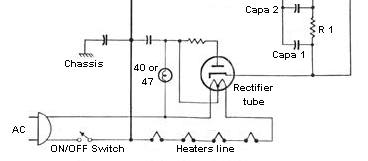
Checking and repairing power supply and filaments line

1/ The first step to repair an old radio is to check the filament of each tube. If one is open, all the line is out of order. So, first of all, take out each tube and check the filament with your ohmmeter. If one is ruined, change the tube.
2/ You also have to check the first capa inside the High Voltage (B+) circuit. It is often shorted and it is very dangerous for the rectifier tube.
3/ Don't forget to check the capacitors between AC line (B-) and the chassis and between AC line (B-) and the rectifier plate. It is very important for your security to work on a chassis which is insulated from the AC.
4/ You also have to check the AC cord. Sometimes it might be badly insulated. In that case, remove it and solder a new one.
Afterwards, you can try to plug in your set but keep your eyes opened : you might have to unplug it quickly if you see something burning inside !
Listen to the speaker to hear the hum and check the B+ : B+ must be close to 100 Volts.
Checking and repairing A.F. power amplifier
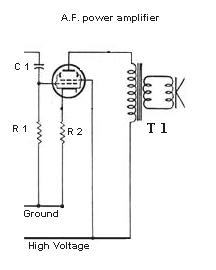
1 - You have no sound ( or a low level sound ) when touching the command grid (G1) and no difference when changing the tube. The heater line is not open and the heater voltages are suitable for the tubes.
First, check High Voltage : it must be about 100 Volts.
If H.V. correct but no H.V. on the plate, check the primary of T 1. Plate voltage must be the same as power supply high voltage.
Secondly, check the cathode voltage and compare it with the command grid bias.
The G 1 bias must be about 7 volts under the cathode voltage to induce a good current.
If the G 1 voltage is too high, check the C 1 capacitor. Sometimes it could be shorted and G 1 should receive a part of the pre-amplifier plate voltage. In this case G 1 should be positive and the tube should be locked or the sound very poor. Sometimes, R 1 could be open ( or could have a very high value ) and the result should be the same. In most of American Radios, C 1 is a part of a multi-capacitor. It's not easy to find these multi-capas today.
If the G 1 bias is correct but the cathode voltage is not, check R 2 ( generally 270 ohms ). If R 2 , R 1 , V G1 , V G2 , V plate are correct, but the cathode voltage is too low, the tube is probably dead ; the current is too low to make a voltage drop through R 2.
Checking and repairing A.F. pre-amplifier
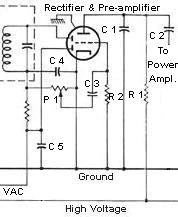
If your pre-amplifier does not work, and you have tried to change the tube, check the plate voltage first. If the high voltage is correct (100V) the pre-amplifier plate voltage must be about 40 volts. If it is too low, check R 1 and C 1. C 1 is a small value capacitor which just allows to drop high audio frequencies. If C 1 is shorted, the current through R1 is increased and the drop voltage is too high. R 1 is a 470K resistor and sometimes, if the current has been too high too long, its value could have changed. The tube is a triode and the grid bias must be negative because the cathode is on ground. To induce a good current, the grid bias must be about -1 Volt. If not, check the bias resistor R 2 ; its value must be 10 Megohms. Also check C 3 ; if it is shorted, the grid bias is near 0 Volt and the tube is locked.
The potentiometer P 1 is frequently responsible for the failure. It is often dirty and induces many cracklings in the speaker. In this case, the only solution is to use a cleaning spray.
Finding a failure in C 4 or C 5 is not frequent.
Checking and repairing I.F. amplifier
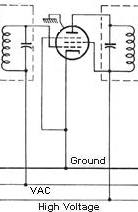
It's very easy to check this part of your radio. All you have to do is to check the plate voltage. It must be close to the high voltage : 100 Volts. The G 2 voltage is the same than High Voltage. The cathode is on ground. The grid bias is at the same value as the VAC line ( near 0 volt when a high level station is tuned on, negative when no station is tuned on) , to increase the current through the tube. Don't forget to check the capacitor between the VAC line and the ground. If it is shorted, the grid bias is always near 0 volt ans the receiver has a very low sensitivity.
Checking and repairing mixer stage
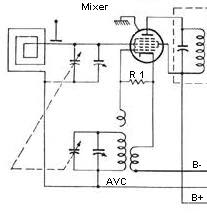
If the heater is OK, the only thing you have to do is to check the plate voltage and the screen voltage. On the plate you must find a value close to B+, and on the screen, the value is B+. The oscillator grid resistor is a 22k for a 12BE6 tube but is different for another tube. If you have a scope you can check the oscillator on this grid.
Return to American Old Radio Home Page.